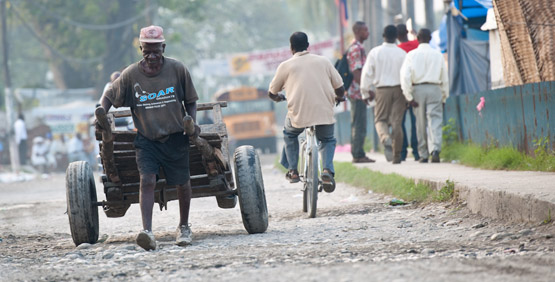
I left Haiti on Friday, spent a night in New York and have been home in Canada for a couple of days. I’m sitting at my kitchen table, listening to the radio, typing away on my computer, sipping on a fruit smoothie and thinking about the nine weeks I spent volunteering in Leogane, the epicentre of the Haitian earthquake. I’ve had a hot shower, my clothes have been washed and my sore bones and wounds are starting to recover. I’ve unpacked my backpack, visited wit family and friends, eaten copious amounts of ice cream, watched some bad TV, relaxed with a book in the sun in the back yard and have just been generally unwinding and decompressing from what was a pretty intense couple of months in Haiti.
The funny thing is, though, that all I really want to do is ge on a plane and head straight back there.
Destruction
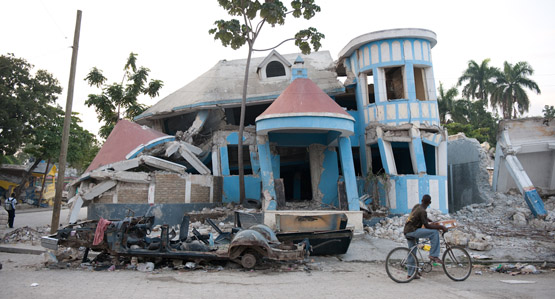
I read somewhere that Leogane has had 90 percent of its buildings damaged or completely destroyed due to the earthquake and this number seems believable as you walk down the city’s streets. I arrived about a month after the quake and while the initial chaos had subsided, the collapsed building, streets filled with rubble and people with lost looks on their faces served as a daily reminder to what had happened. The mayor’s office is still standing but the huge cracks in the walls make it uninhabitable and serve as a reminder of the devastation. Everything from small family homes to huge buildings seem to have been damaged in some way… most seriously. The earthquake only lasted 37 seconds and it’s amazing to me the destruction it caused.
Clean Up
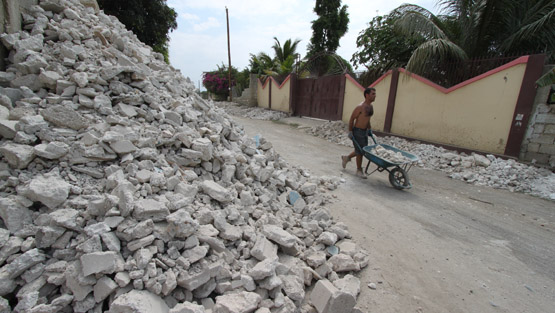
In the nine weeks I was there from March 16th to May 21st I saw and participated in the clean up operation. HODR have cleared over 70 foundations of rubble, giving those families an opportunity to move out of camps and back to a space of their own. Some super scary buildings that I have used as landmarks since my arrival have been cleared up by Haitian cash-for-work teams at a slow, but steady pace. The UN and an NGO called CHF have huge trucks and diggers and have been hauling rubble from the streets out to a flood plane on the edge of town. Progress is being made and it’s encouraging to see the changes in the landscape after two months but with the scale of this disaster, there will be rubble and damaged buildings in Leogane for a long time to come.
Shelter

Probably the most depressing part of this whole thing is seeing the camps many people are still living in. Some people have Shelterbox or other high quality tents but many are still living in shacks made of old, rusty corrugated tin roofing or, worse still, bed sheets and tarps. I can’t imagine how people in these structures deal with the oppressive heat and the sometimes torrential rains and I don’t even want to think about what will happen as hurricane season approaches. With the amount of money that has been donated to Haiti it seems unfathomable that everyone doesn’t have at least a decent tent or a set of tarps to make a shelter.
I don’t know how the Red Cross works but the only thing I’ve seen with their logo on it in Leogane is their SUVs as they drive through town. I’ve seen a few tarps around with US AID on them, some Samaritan’s Purse tarps over schools, and the Canadian military had a bit of a presence here early on. CHF, who are operating out of our backyard, have been prefabricating and distributing transitional steel houses to people and it’s encouraging to see them popping up around town.
Rebuilding
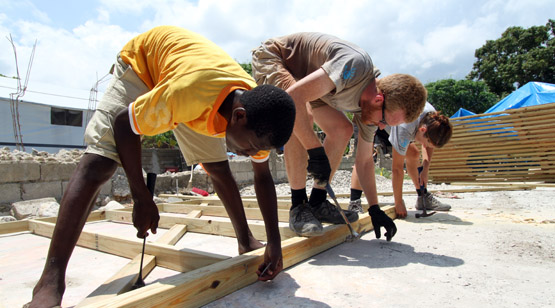
Very little rebuilding has begun. I’ve seen a few giant houses being reconstructed but my guess is their owned by some of the few but super wealthy people that live in Haiti. Some cinder block factories have been pumping out more bricks but who knows if the standard is any higher than before the earthquake. My guess is not.
A few transitional schools have been popping up made of plywood with a corrugated iron roof. HODR have just completed their first school and there are a bunch more in the pipeline. The schools are similar to the house design used in Indonesia and with thin concrete walls, the structure looks like a regular building from the outside, is sturdy, and doesn’t have heavy bricks that could fall in an earthquake.
Work
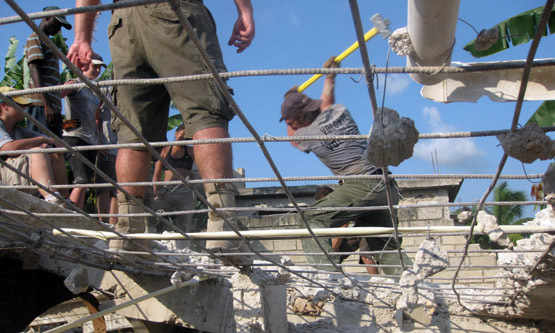
Clearing rubble is hard work but it’s something I’ve done before so I knew what I was in for. What took me by surprise was the crazy hot days. The weather was hot but bearable when I arrived in March but by the time I left in May, the humidity combined with the relentless sun made Haiti the hottest place I’ve ever been. Throw in some seriously physical work and I’m amazed I survived!
We often had four or five teams of people out clearing rubble each day. The basic idea is to clear the foundation so that rebuilding can begin or, more likely, so that families can return to their own space and set up a tent outside of a camp. It’s really tough work, especially since almost all of the buildings are huge, concrete beasts, usually with their roof intact and the walls collapsed. Teams descend on the building with sledge hammers to break up the roof and then need to pull out the reinforcement bar (rebar) that’s threaded through the roof like a puzzle. This is slow work but once the rebar is taken out (to be used again), the rubble removal pace picks up and the rest of the house is sledged, shovelled and taken by wheelbarrow out to the streets.
I also ended up spending some of my time working on taking photos and sorting and uploading them to the Flickr site which is a lot more time consuming that you would think. I spent three days behind a jigsaw cutting patterns into plywood for the first school and was on the build team for the last three weeks of my time in Haiti. I somehow found myself leading the team putting concrete onto the walls even though I usually avoid leading as much as possible. I really enjoyed it though and was sad to have to leave a few days before we were due to finish. I loved working on the school and can’t wait to see the photos when its done.
Life in Leogane
I love Haiti and the country continues to amaze me on this second visit. Haiti is pretty screwed and earthquakes and hurricanes add to the misery but people here amaze me each day. I’ve picked up a bit of Creole and have been able to have short, simple conversations with people who have lost everything. I am always in awe of the amount of faith people who have been stomped on can have in god and, here in Haiti, they have it in bucketloads. I’m not big into spirituality and religion but there’s got to be a lesson in there somewhere. It’s amazing to me and if that’s what keeps people here smiling and hopeful (and they are) then praise Jesus!
I think it’s the people I meet on each project who keep me coming back to work with HODR. Sure, the whole helping thing is great but it takes a bit more than wanting to help to get most people to fly to the opposite side of the world five times in two years, and I’m no different. I love the HODR atmosphere and the types of people it attracts and that, coupled with my desire to do some hard work and help people, is the reason I’m hooked. I have a lot of good friends through this volunteering thing and continue to meet more amazing people on each project and having a chance to live and work with them each day is pretty great.
Life on base was pretty easy when compared to other HODR projects. This project was pimped out with lots of showers, plenty of meat for lunch and dinner, power tools, sexy wheelbarrows, and all of those little things that add up to make our life here enjoyable. More recently, we even had pizza nights twice a week at the bar next door. The only major difficulty I had was dealing with the heat and having a bunk space without much of a breeze. Overall, life at the HODR base was really enjoyable.
Check out this post written by a visitor from Expedia for an outsider’s view on volunteering with HODR with video. I knew I should have taken more video!
Final Thoughts
I was sad to leave and would have stayed much longer had I not already made plans to go to South Africa for the World Cup. I love Haiti and loved being back there, even if I was there for a terrible reason. I have already found myself looking at flights from South Africa to Haiti via Miami or New York for around October. I want to explore Africa but Haiti seems to have this pull over me and it will always be on my mind.
Leave a Reply